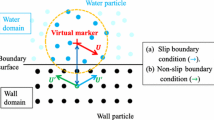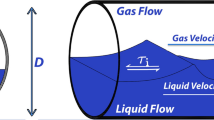Abstract
This paper presents a numerical investigation of the flow characteristics around a freely falling square shape particle in a two-dimensional channel. The FSI (fluid-solid interaction) has been realized by using the direct-forcing/fictitious domain (DF/FD) method. In order to identify the effect of fluid property on the flow characteristics and solid motion by FSI, a wide range of the fluid viscosity has been considered, which introduces various Reynolds numbers to this study. In addition, the off-centered distance of the square particle has been imposed to research the effect of the initial position. The centered particle is freely falling without rotation and transverse motion. However, the motion of the off-centered particle is significantly depended on the Reynolds number, so it is classified into the four regimes by the flow and moving characteristics of the particle. Quantitative information about the drag coefficient on the square particle is highlighted.
Similar content being viewed by others
References
S. L. Soo, Particulates and Continuum: Multiphase Fluid Dynamics, Hemisphere, (1989).
D. Gidaspow, Multiphase Flow and Fluidization, Academic Press, (1994).
E. Guazzelli and L. Oger, Mobile Particulate Systems, Kluwer Academic, (1995).
K. Pye and H. Tsoar, Aeolian Sand and Sand Dunes, Unwin Hyman, (1990).
K. Höfler and S. Schwarzer, Navier-Stokes simulation with constraint forces: finite-difference method for particle-laden flows and complex geometries, Phys. Rev. E, 61(6) (2000) 7146–7160.
Z. Feng and E. E. Michaelides, Proteus: a direct forcing method in the simulations of particulate flows, J. Comput. Phys., 202 (2005) 20–51.
H. H. Hu, D. D. Joseph and M. J. Crochet, Direct numerical simulation of fluid particle motions, Theoret. Comput. Fluid Dyn., 3 (1992) 285–306.
H. H. Hu, Direct simulation of flows of solid-liquid mixtures, Int. J. Multiphase Flows, 22 (1996) 335–352.
H. H. Hu, N. A. Patankar and M. Y. Zhu, Direct numerical simulation of fluid solid systems using Arbitrary Lagrangian-Eulerian technique, J. Comput. Phys., 169 (2001) 427–462.
A. A. Johnson and T. E. Tezduyar, Simulation of multiple spheres falling in a liquid-filled tube, Comput. Methods Appl. Mech. Eng., 134 (1996) 351–373.
Z. Wang, J. Fan and K. Luo, Combined multi-direct forcing and immersed boundary method for simulating flows with moving particles, Int. J. Multiphase Flow, 34 (2008) 283–302.
R. Glowinski, T.-W. Pan, T. I. Hesla and D. D. Joseph, A distributed Lagrange multiplier/fictitious domain method for particulate flows, Int. J. Multiphase Flow, 25 (1999) 755–794.
R. Glowinski, T.-W. Pan, T. I. Helsa, D. D. Joseph and J. Periaux, A fictitious domain approach to the direct numerical simulation of incompressible viscous flow past moving rigid bodies: application to particulate flow, J. Comput. Phys., 169 (2001) 363–426.
Z. Yu and X. Shao, A direct-forcing fictitious domain method for particulate flows, J. Comput. Phys., 227 (2007) 292–314.
C. S. Peskin, Flow patterns around heart valves: a numerical method, J. Comput. Phys., 10 (1972) 252–271.
N. A. Patankar, P. Singh, D. D. Joseph, R. Glowinski and T.-W. Pan, A new formulation of the distributed Lagrange multiplier/fictitious domain method for particulate flows, Int. J. Multiphase Flow, 26 (2000) 1509–1524.
M. Uhlmann, An immersed boundary method with direct forcing for the simulation of particulate flows, J. Comput. Phys., 209 (2005) 448–476.
Z. Yu, X. Shao and A. Wachs, A fictitious domain method for particulate flows with heat transfer, J. Comput. Phys., 217 (2006) 424–452.
Z. Yu, A. Wachs and Y. Peysson, Numerical simulation of particle sedimentation in shear-thinning fluids with a fictitious domain method, J. Non-Newtonian Fluid Mech., 136 (2006) 126–139.
N. Sharma and N. A. Patankar, A fast computation technique for the direct numerical simulation of rigid particulate flows, J. Comput. Phys., 205 (2005) 439–457.
Z. Yu and A. Wachs, A fictitious domain method for dynamics simulation of particle sedimentation in Bingham fluids, J. Non-Newtonian Fluid Mech., 145 (2007) 78–91.
A. Wachs, A DEM-DLM/FD method for direct numerical simulation of particulate flows: Sedimentation of polygonal isometric particle in a Newtonian fluid with collisions, Comput. Fluids, 38 (2009) 1608–1628.
A. Haider and O. Levenspiel, Drag coefficient and terminal veolocity of spherical and nonspherical particles, Power Technol., 58 (1989) 63–70.
E. A. Fadlun, R. Verzicco, P. Orlandi and J. Mohd-Yusof, Combined immersed boundary finite-difference methods for three-dimensional complex flow simulations, J. Comput. Phys., 161 (2000) 35–60.
A. M. Roma, C. S. Peskin and M. J. Berger, An adaptive version of the immersed boundary method, J. Comput. Phys., 153 (1999) 509–534.
H. Choi and P. Moin, Effects of the computational Time Step on Numerical Solutions of Turbulent Flow, J. Comput. Phys., 113 (1994) 1–4.
J. Feng, H. H. Hu and D. D. Joseph, Direct simulation of initial value problems for the motion of solid bodies in a Newtonian fluid: Part 1. Sedimentation, J. Fluid Mech., 261 (1994) 95–134.
Author information
Authors and Affiliations
Corresponding author
Additional information
This paper was recommended for publication in revised form by Associate Editor Haecheon Choi
Man-Yeong Ha received his B.S. degree from Pusan National University, Korea, in 1981, M.S. degree, in 1983, from Korea Advanced Institute of Science and Technology, Korea, and Ph.D. degree from Pennsylvania State University, USA in 1990. Dr. Ha is currently a Professor at the School of Mechanical Engineering at Pusan National University in Busan, Korea. He serves as an Editor of the Journal of Mechanical Science and Technology. His research interests are focused on thermal management, computational fluid dynamics, and micro/ nano fluidics.
Changyoung Choi received his B.S. and M.S. degrees from Pusan National University, Korea, in 2008 and 2010, respectively. In his master course, he conducted many researches under the supervision of Prof. Man-Yeong Ha. His research interests are focused on flow analysis and control in turbulent flows and thermo-fluid phenomena analysis for enhancing the efficiency of the industrial devices.
Rights and permissions
About this article
Cite this article
Choi, C., Yoon, HS. & Ha, MY. Flow around a freely falling square shape particle in a channel using direct-forcing fictitious domain method. J Mech Sci Technol 24, 1441–1449 (2010). https://doi.org/10.1007/s12206-010-0422-4
Received:
Revised:
Accepted:
Published:
Issue Date:
DOI: https://doi.org/10.1007/s12206-010-0422-4




